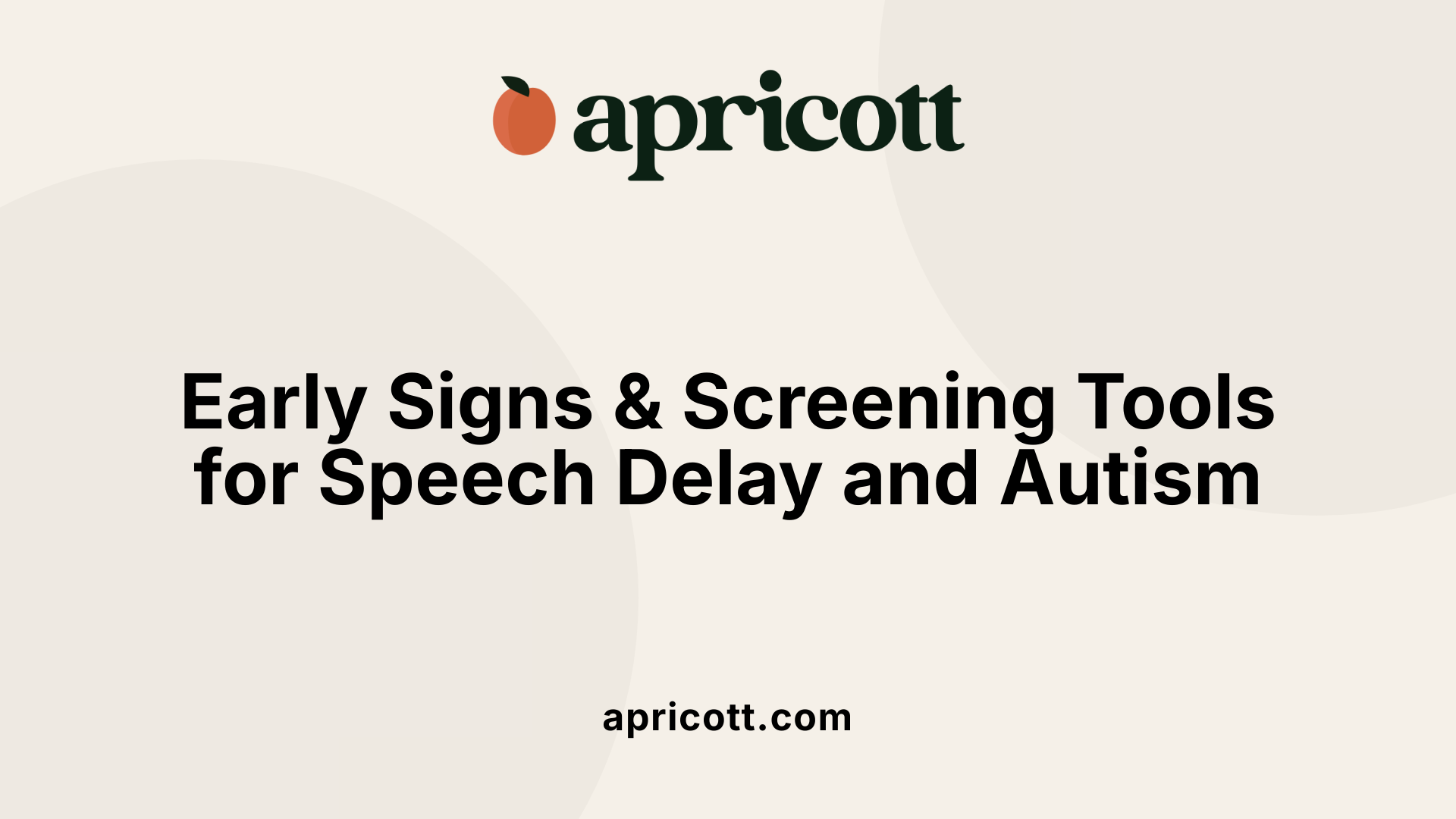Recognizing Early Signs and Their Importance
Speech delay and autism spectrum disorder (ASD) both affect communication development in children but in distinct ways. Knowing how to differentiate between the two enables early intervention, which is crucial for optimizing developmental outcomes. This article explores key differences, diagnostic considerations, and treatment approaches, emphasizing the role of interventions such as Applied Behavior Analysis (ABA) therapy.
Defining and Differentiating Speech Delay and Autism

Typical speech development milestones
Children usually start babbling by 12 months, produce simple words by 16 months, and combine words by 24 months. They also begin using gestures like pointing by 18 to 24 months and respond to their name early on.
Causes and characteristics of speech delay
Speech delay can be due to hearing loss, oral-motor difficulties, genetic conditions such as Down's syndrome, or environmental factors. Children with speech delays show late onset in speaking but generally have normal social interaction skills. They maintain eye contact, respond to their name, and use body language naturally. Their receptive language skills often exceed expressive skills.
Core features of autism and its impact on communication
Autism spectrum disorder (ASD) involves broader developmental challenges including social communication difficulties, limited eye contact, reduced shared attention, repetitive behaviors, and sensory processing differences. Children with autism may not babble by 12 months, stop babbling, show limited gestures, and prefer playing alone. They might repeat words or phrases (echolalia) and have trouble understanding nonverbal cues.
Social behaviors distinguishing speech delay from autism
The main difference lies in social engagement: children with speech delay actively seek social interaction and communicate with gestures and eye contact, whereas children with autism often avoid eye contact, struggle with social reciprocity, and may prefer solitude. Autistic children also display repetitive movements and have restricted interests that are not typical in speech delay.
Main differences between speech delay and autism-related speech delay
Speech delay affects speech production, vocabulary, and grammar but usually does not impair social engagement or nonverbal communication. In contrast, autism affects multiple developmental areas including social communication and behavior. Children with autism may stop babbling and show limited gestures, while children with speech delay maintain social motivation and use nonverbal communication effectively.
Early Signs and Assessment Strategies

Typical speech milestones and red flags
Children usually begin to babble by 12 months, speak their first words by 16 months, and combine two words by 24 months. Other early milestones include pointing to objects around 18-24 months and using simple phrases. Missing these milestones can signal a speech delay. For example, a child who does not babble by 12 months or combine words by 24 months may require further assessment.
Behavioral signs indicating autism
Autism spectrum disorder (ASD) includes social communication challenges beyond speech delay. Signs often involve difficulty responding to their name, avoiding eye contact, not using or imitating gestures, persistent repetition of words or phrases (echolalia), preference for solitude, and repetitive behaviors. Children with autism may show limited joint attention and sensory sensitivities more than children with only speech delay.
Assessment tools for speech delay and autism
Assessment typically involves standardized tools tailored to each condition. For speech delays, instruments like the Clinical Evaluation of Language Fundamentals-Preschool (CELF-P) and the Preschool Language Scale (PLS) focus on speech and language skills. For autism screening, the Modified Checklist for Autism in Toddlers (M-CHAT) and the Ages and Stages Questionnaires (ASQ) help identify social communication challenges and restrictive behaviors. Multidisciplinary evaluations including speech-language pathologists, psychologists, and pediatricians enhance diagnostic accuracy.
When to seek professional evaluation
Parents and caregivers should seek professional evaluation if a child shows no babbling by 12 months, does not produce words by 16 months, or fails to combine words by 24 months. Additionally, children exhibiting social withdrawal, poor eye contact, repetitive behaviors, or lack of response to their name should be evaluated for autism spectrum disorder. Early evaluation enables timely intervention, which significantly improves developmental outcomes across communication, social, and cognitive domains.
The Importance of Early Intervention and Therapy

Benefits of timely diagnosis on developmental outcomes
Early detection of speech delay or autism spectrum disorder (ASD) dramatically improves developmental outcomes. Children identified before or by 24 months who receive timely intervention often show accelerated improvements across physical, cognitive, communication, self-help, and social/emotional domains. Early diagnosis enables targeted therapies, reducing the severity of long-term challenges and minimizing the need for extensive special education services later on.
Types of therapies for speech delay
Speech delay primarily calls for speech-language therapy, which focuses on enhancing speech sound production, vocabulary, grammar, receptive and expressive language skills. Therapy commonly employs play-based activities, repetition, and visual aids to foster natural learning, with active family participation to reinforce progress. Parental coaching also supports consistent language stimulation at home, which is critical for sustained improvements.
Overview of interventions for autism affecting communication and behavior
Interventions for autism are multidisciplinary and individualized, addressing broader developmental needs beyond speech. Behavioral therapies such as Applied Behavior Analysis (ABA) develop social and communication skills. Speech therapy is tailored to help functional communication, including understanding nonverbal cues and promoting pragmatic language. Occupational therapy works on motor skills and sensory processing, while augmentative and alternative communication (AAC) tools support nonverbal children. Integration of these services ensures comprehensive support for children with ASD, fostering improved communication and social engagement.
Applied Behavior Analysis (ABA) Therapy: An Overview

What is Applied Behavior Analysis (ABA) therapy and how is it used in treating autism?
Applied Behavior Analysis (ABA) therapy is a scientific approach rooted in the principles of learning and behavior. It is widely recognized as an effective treatment for autism spectrum disorder (ASD). The therapy focuses on encouraging positive behaviors including enhanced communication, social skills, and daily living tasks, while reducing behaviors that may interfere with learning or social interaction.
ABA employs strategies such as positive reinforcement — rewarding desirable behaviors to encourage their recurrence — and prompting, which helps guide children to perform new skills step by step. These techniques help children with autism develop important skills like social communication and manage challenging behaviors.
Goals and methods of ABA therapy
The primary goal of ABA therapy is to improve quality of life by building functional skills and promoting independence. Therapists create individualized programs tailored to each child's unique needs, often involving repetitive teaching and positive feedback. Key methods include teaching social communication, turn-taking, understanding nonverbal cues, and self-help skills through play-based activities.
Settings and delivery of ABA interventions
ABA therapy is flexible and can be delivered in various natural environments such as a child's home, school, or community settings. This approach ensures that learned skills generalize beyond the therapy sessions. Sessions often include family participation to reinforce skills in everyday contexts.
Given its evidence-based design, ABA remains a cornerstone treatment for autism, supporting children in achieving developmental milestones, improving communication, and fostering social engagement.
Who Provides ABA Therapy and How Is It Tailored?
Qualifications of ABA Professionals
ABA therapy is provided primarily by Board Certified Behavior Analysts (BCBAs). These professionals hold graduate degrees specializing in Applied Behavior Analysis, have completed extensive supervised fieldwork, and passed the Behavior Analyst Certification Board (BACB) exam. Many also maintain state licensure and participate in ongoing education to ensure adherence to ethical standards and best practices.
Roles of Board Certified Behavior Analysts and Behavior Technicians
BCBAs lead the development and oversight of individualized treatment plans. They conduct thorough assessments to identify each child's strengths and needs, design intervention strategies, and monitor progress through data analysis. Registered Behavior Technicians (RBTs), under BCBA supervision, implement daily therapy sessions, working directly with children to reinforce skills and behaviors.
Personalization of ABA Programs
ABA therapy programs begin with a comprehensive evaluation to determine specific behavioral and communication goals. These programs emphasize personalized strategies using positive reinforcement, one-on-one interactions, and play-based methods. Continuous monitoring allows for timely modifications ensuring the program remains aligned with the child's evolving needs.
Family Involvement and Ongoing Progress Monitoring
Family participation is integral to ABA therapy's success. Caregivers are educated on techniques to support skill development consistently across environments. Regular progress reviews between the therapy team and family help adjust goals and reinforce learning, promoting meaningful and lasting improvements.
Maximizing Outcomes: Integrating Speech Therapy and Behavioral Approaches
What are the goals of speech therapy for speech delay and autism?
Speech therapy aims to enhance speech sound production, vocabulary development, and expressive language in children with speech delay. For children with autism, therapy additionally focuses on social communication skills such as turn-taking, understanding nonverbal cues, and pragmatic language use. Tailoring therapy to address specific needs helps children improve communication and engagement.
How does speech therapy support social communication in autism?
In autism, speech therapy incorporates play-based activities, repetition, and visual aids to teach both verbal and nonverbal communication skills. It encourages functional communication through strategies like augmentative and alternative communication (AAC), including picture exchange systems and speech-generating devices. Therapy also targets social skills such as joint attention and recognizing social cues, which are often challenging for children on the spectrum.
Why is an interdisciplinary approach important?
Effective intervention often involves collaboration among speech-language pathologists, occupational therapists, developmental pediatricians, and psychologists. Occupational therapy complements speech therapy by improving motor skills and sensory processing, critical for children with autism who may exhibit repetitive movements and sensory sensitivities. This multidisciplinary model provides holistic support addressing communication, behavior, motor, and sensory needs.
What role do parents play in reinforcing progress?
Parental involvement is crucial for generalizing skills learned in therapy. Therapists engage families through coaching and encouraging practice of communication strategies at home. This consistent reinforcement boosts language acquisition and social interaction in everyday settings, resulting in better long-term outcomes. Family participation also ensures that therapy approaches match the child's unique environment and preferences.
Early Recognition and Individualized Care for Better Futures
Distinguishing between speech delay and autism spectrum disorder is vital for implementing appropriate interventions that address each child's unique needs. While speech delay mainly impacts verbal communication, autism includes broader social and behavioral challenges requiring comprehensive therapies like ABA and speech therapy. Early professional evaluation combined with personalized, multidisciplinary care can significantly enhance developmental trajectories, empowering children and families toward greater independence and quality of life.
References
- Speech Delay versus Autism: What's the Difference?
- The Difference Between Speech Delays and Autism
- Speech delay vs. autism
- Speech Delay vs Autism: A Guide for Mental Health ...
- Speech Delay or Autism? Understanding the Signs
- Speech Delay vs. Autism: Identifying the Differences
- How to Tell the Difference Between Speech Delay & Autism
.svg)
.svg)








